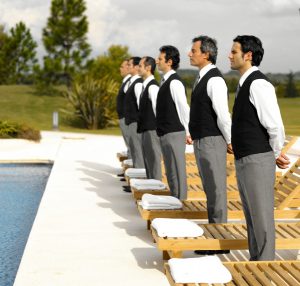Temperatures Rising: Precautions Needed for Hotel Employees and Guests
At the start of summer the Occupational Safety and Health Administration (OSHA) reinforced the need for businesses and establishments – including hotels – to take extra measures to prevent heat stroke and other related illnesses among employees. According to the U.S. Department of Labor, in 2014 alone 2,630 workers suffered from heat illness and 18 individuals actually died on the job from heat stroke and related causes. Moreover, it’s not only hotel employees, particularly landscape and maintenance crew, who need to worry about heat-related illnesses, but also guests, who are basking in the sun poolside, using a sunbed, or enjoying the establishment’s sauna or steam room facilities.
Under OSHA, employers have a duty to protect workers from recognized serious hazards in the workplace, including heat-related risks. How do heat illnesses occur? The body normally cools itself by sweating; however, during hot weather, especially with high humidity, sweating alone is simply not enough. Your body temperature can rise to dangerous levels if precautions are not taken.
OSHA recommends taking the following measures, which in some cases can also apply to hotel guests in addition to employees:
- Plan for emergencies and train workers on prevention. Have a written emergency plan in place.
- Monitor weather events or major changes in temperature throughout the workday.
- Establish and maintain communication between employees and supervisors. In addition, set up procedures for contacting emergency response services and administering first aid and train employees accordingly.
- Monitor workers for signs of illness.
- Ensure workers are provided water. Also, provide air-conditioned or shaded areas close to the work area and schedule frequent rest breaks. Implement more frequent breaks during the first week of work in high-heat conditions and develop a work/rest regiment that establishes how often and when breaks should be taken.
- Make work schedule changes as appropriate. Examples include: rescheduling all non-essential outdoor work for days with a reduced heat index; scheduling the more physically demanding work during the cooler times of day and the less physically demanding work during warmer times of the day; rotating workers or using split shifts; and stopping work if essential control methods are inadequate or unavailable when the risk of heat illness is very high.
- New or returning workers should gradually increase their workloads and take more frequent breaks as they acclimate, or build a tolerance for working in the heat, as those new to outdoor jobs are generally most at risk for heat-related illnesses.
Employees should follow these measures to prevent heat-related incidents:

- Drink water every 15 minutes, even if not thirsty.
- Rest to cool down.
- Wear light-colored clothing.
- Learn the signs of heat illness and what to do in an emergency. Common signs of heat exhaustion include headaches, dizziness, lightheadedness, or fainting; extreme weakness; profuse sweating; irritability; nausea or vomiting; and cramps. Common signs for heat stroke include dry, hot skin with no sweating; strong, rapid pulse; dizziness and nausea; confusion or irrational behavior; seizures or convulsions; and loss of consciousness.
- Keep an eye on fellow colleagues.
- Take it “easy” on the first days of work in extreme heat, in order to get used to the high temperatures.
If a worker becomes ill, make sure employees know to call a supervisor for help. If a supervisor is not available, they should call 911. Someone should stay with the worker until help arrives. If a guest becomes ill also contact 911 immediately and be sure a hotel employee remains with the guest until medical help arrives. Also, move the affected person to a cool, shaded area; loosen or remove any heavy clothing; provide cool (but not cold) drinking water; and fan and mist the person with water.




